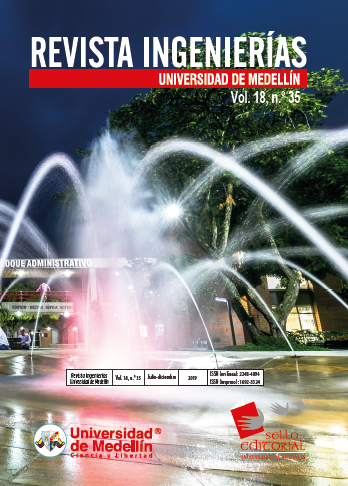Changes in the Chemical Structure of High-Density Polyethylene when Undergoing Multiple Reprocessing
DOI:
https://doi.org/10.22395/rium.v18n35a7Keywords:
thermal degradation, FTIR, injection reprocessing, extrusion reprocessing, high-density polyethyleneAbstract
In this paper, which presents the original results of a research funded by Colciencias and Facultad de IngenierÃa y Arquitectura from the Universidad Nacional de Colombia, headquarters Manizales, publishes the changes of high-density polyethylene extrusion and injection grade identified after being subjected to five reprocessing processes in extrusion, injection and extrusion/injection. The identification of the changes is made through the comparison of the FTIR spectrum with those reported in different bibliographical references. The spectra were obtained by means of a Platinum ATR spectrometer. The thermal degradation was greater in the extrusion/injection process, followed by injection, extrusion at 80 rpm and extrusion at 20 rpm. It is concluded that there is a low degradation of high-density polyethylene after being reprocessed in five cycles, evidencing the appearance of the carbonyl group, vinyl groups and COC group.
Downloads
References
[1] N. Singh, D. Hui, R. Singh, I. Ahuja, L. Feo y F. Fraternali, “Recycling of plastic solid waste: A state of art review and future applications,†Composites Part B: Engineering, vol. 115, pp. 409-422, 2017.
[2] C. Breen, P. M. Last, S. Taylor y P. Komadel, “Synergic chemical analysis - The coupling of TG with FTIR, MS and GC-MS 2. Catalytic transformation of the gases evolved during the thermal decomposition of HDPE using acid-activated clays,†Thermochimica Acta, vol. 363, pp. 93-104, 2000.
[3] A. F. Rojas y T. Osswald, “Determinación de la degradación térmica de polÃmeros por análisis de cambio de color,†IngenierÃa, vol. 21, n.º 1, pp. 19-30, 2016.
[4] A. F. Rojas-González y L. M. Aranzazu-RÃos, “Estabilidad de procesamiento de polÃmeros: Ãndice de degradación en proceso,†Revista Mutis, vol. 5, n.º 1, pp. 37-45, 2015. DOI: https://doi.org/10.21789/22561498.1017
[5] A. A. Cuadri y J. E. MartÃn-Alfonso, “The effect of thermal and thermo-oxidative degradation conditions on rheological, chemical and thermal properties of HDPE,†Polymer Degradation and Stability, vol. 141, pp. 11-18, 2017.
[6] M. J. Abad, A. Ares, L. Barral, J. Cano, F. J. DÃez, S. GarcÃa-Garabal, J. López y C. RamÃrez, “Effects of a mixture of stabilizers on the structure and mechanical properties of polyethylene during reprocessing,†Journal of Applied Polymer Science, vol. 92, n.º 6, pp. 3910-3916, 2004.
[7] S. Apone, R. Bongiovanni, M. Braglia, D. Scalia y A. Priola, “Effects of thermomechanical treatments on HDPE used for TLC ducts,†Polymer testing, vol. 22, n.º 3, pp. 275-280, 2003.
[8] N. Benoit, R. González-Núñez y D. Rodriguez, “High Density Polyethylene Degradation Followed by Closed- loop Recycling,†Progress in Rubber, Plastics and Recycling Technology, vol. 33, n.º 1, pp. 17-37, 2017.
[9] H. Hifumi, A. V. Ewing y S. G. Kazarian, “ATR-FTIR spectroscopic imaging to study the drying and dissolution of pharmaceutical polymer-based films,†International Journal of Pharmaceutics, vol. 515, n.º 1, pp. 57-68, 2016.
[10] T. Corrales, F. Catalina, C. Peinado, N. S. Allen y E. Fontan, “Photooxidative and thermal degradation of polyethylenes: Interrelationship by chemiluminescence, thermal gravimetric analysis and FTIR data,†Journal of Photochemistry and Photobiology A: Chemistry, vol. 147, n.º 3, pp. 213-224, 2002.
[11] L. C. Mendes, E. S. Rufino, F. O. De Paula y A. C. Torres, “Mechanical, thermal and microstructure evaluation of HDPE after weathering in Rio de Janeiro City,†Polymer Degradation and Stability, vol. 79, n.º 3, pp. 371-383, 2003. DOI: https://doi.org/10.1016/S0141-3910(02)00337-3
[12] V. Parthasarathi, B. Sundaresan, V. Dhanalakshmi y R. Anbarasan, “Functionalization of HDPE with aminoester and hydroxyester by thermolysis method-An FTIR-RI approach,†Thermochimica Acta, vol. 510, n.º 1, pp. 61-67, 2010.
[13] C. A. Wilkie, “TGA/FTIR: an extremely useful technique for studying polymer degradation,†Polymer Degradation and Stability, vol. 66, pp. 301-306, 1999.
[14] D. S. Achilias, C. Roupakias, P. Megalokonomos, A. A. Lappas y V. Antonakou, “Chemical recycling of plastic wastes made from polyethylene (LDPE and HDPE) and polypropylene (PP),†Journal of Hazardous Materials, vol. 149, n.º 3, pp. 536-542, 2007.
[15] J. V. Gulmine, P. R. Janissek, H. M. Heise y L. Akcelrud, “Polyethylene characterization by FTIR,†Polymer Testing, vol. 21, n.º 5, pp. 557-563, 2002.
[16] B. C. Smith, Fundamentals of Fourier transform infrared spectroscopy, London: CRC Press, 2011.
[17] Y. Kann, M. Shurgalin y R. K. Krishnaswamy, “FTIR spectroscopy for analysis of crystallinity of poly(3-hydroxybutyrate-co-4 -hydroxybutyrate) polymers and its utilization in evaluation of aging, orientation and composition,†Polymer Testing, vol. 40, pp. 218-224, 2014.
[18] M. K. Loultcheva, M. Proietto, N. Jilov y F. P. La Mantia, “Recycling of high density polyethylene containers,†Polymer degradation and stability, vol. 57, n.º 1, pp. 77-81, 1997.
[19] P. Oblak, J. González-Gutiérrez, B. ZupanÄiÄ, A. Aulova y I. Emri, “Processability and mechanical properties of extensively recycled high density polyethylene,†Polymer Degradation and stability, vol. 114, pp. 133-145, 2015.
[20] I. Kriston, E. Földes, P. Staniek y B. Pukánszky, “Dominating reactions in the degradation of HDPE during long term ageing in water,†Polymer Degradation and Stability, vol. 93, n.º 9, pp. 1715-1722, 2008.
[21] A. Kumar, T. Venkatappa-Rao, S. Ray-Chowdhury, y S. V. Ramana-Reddy, “Compatibility confirmation and refinement of thermal and mechanical properties of poly (lactic acid)/poly (ethylene-co-glycidyl methacrylate) blend reinforced by hexagonal boron nitride,†React. Funct. Polyme., vol. 117, pp. 1-9, 2017. DOI: https://doi.org/10.1016/j.reactfunctpolym.2017.05.005
[22] A. S. F. Santos, J. A. M. Agnelli, D. W. Trevisan y S. Manrich, “Degradation and stabilization of polyolefins from municipal plastic waste during multiple extrusions under different reprocessing conditions,†Polymer Degradation and Stability, vol. 77, n.º 3, pp. 441-447, 2002.
[23] J. R. Riba, J. Cailloux, R. Cantero, R. Canals y M. L. Maspoch, “Multivariable methods applied to FTIR: A powerful technique to highlight architectural changes in poly(lactic acid),†Polym. Test., vol. 65, pp. 264-269, 2018. DOI: https://doi.org/10.1016/j.polymertesting.2017.12.003
Downloads
Published
How to Cite
Issue
Section
License
The total or partial reproduction of the contents of the journal for educational, research, or academic purposes is authorized as long as the source is cited. For reproduction for other purposes, express authorization from the Sello Editorial Universidad de MedellÃn is required.

